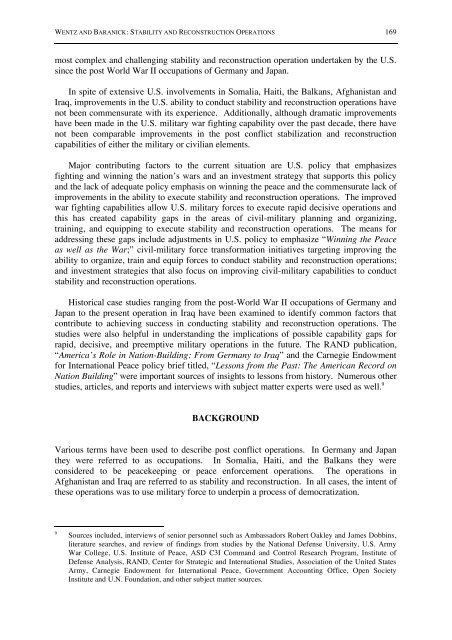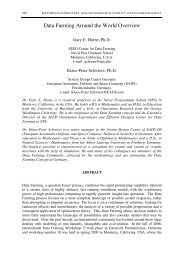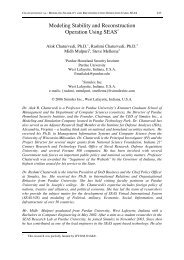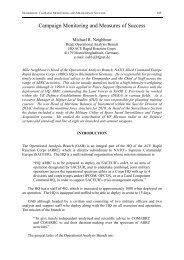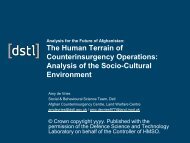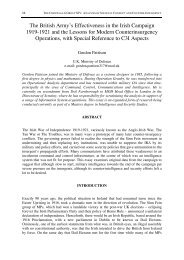Stability and Reconstruction Operations: What ... - Cornwallis Group
Stability and Reconstruction Operations: What ... - Cornwallis Group
Stability and Reconstruction Operations: What ... - Cornwallis Group
You also want an ePaper? Increase the reach of your titles
YUMPU automatically turns print PDFs into web optimized ePapers that Google loves.
WENTZ AND BARANICK: STABILITY AND RECONSTRUCTION OPERATIONS 169<br />
most complex <strong>and</strong> challenging stability <strong>and</strong> reconstruction operation undertaken by the U.S.<br />
since the post World War II occupations of Germany <strong>and</strong> Japan.<br />
In spite of extensive U.S. involvements in Somalia, Haiti, the Balkans, Afghanistan <strong>and</strong><br />
Iraq, improvements in the U.S. ability to conduct stability <strong>and</strong> reconstruction operations have<br />
not been commensurate with its experience. Additionally, although dramatic improvements<br />
have been made in the U.S. military war fighting capability over the past decade, there have<br />
not been comparable improvements in the post conflict stabilization <strong>and</strong> reconstruction<br />
capabilities of either the military or civilian elements.<br />
Major contributing factors to the current situation are U.S. policy that emphasizes<br />
fighting <strong>and</strong> winning the nation’s wars <strong>and</strong> an investment strategy that supports this policy<br />
<strong>and</strong> the lack of adequate policy emphasis on winning the peace <strong>and</strong> the commensurate lack of<br />
improvements in the ability to execute stability <strong>and</strong> reconstruction operations. The improved<br />
war fighting capabilities allow U.S. military forces to execute rapid decisive operations <strong>and</strong><br />
this has created capability gaps in the areas of civil-military planning <strong>and</strong> organizing,<br />
training, <strong>and</strong> equipping to execute stability <strong>and</strong> reconstruction operations. The means for<br />
addressing these gaps include adjustments in U.S. policy to emphasize “Winning the Peace<br />
as well as the War;” civil-military force transformation initiatives targeting improving the<br />
ability to organize, train <strong>and</strong> equip forces to conduct stability <strong>and</strong> reconstruction operations;<br />
<strong>and</strong> investment strategies that also focus on improving civil-military capabilities to conduct<br />
stability <strong>and</strong> reconstruction operations.<br />
Historical case studies ranging from the post-World War II occupations of Germany <strong>and</strong><br />
Japan to the present operation in Iraq have been examined to identify common factors that<br />
contribute to achieving success in conducting stability <strong>and</strong> reconstruction operations. The<br />
studies were also helpful in underst<strong>and</strong>ing the implications of possible capability gaps for<br />
rapid, decisive, <strong>and</strong> preemptive military operations in the future. The RAND publication,<br />
“America’s Role in Nation-Building: From Germany to Iraq” <strong>and</strong> the Carnegie Endowment<br />
for International Peace policy brief titled, “Lessons from the Past: The American Record on<br />
Nation Building” were important sources of insights to lessons from history. Numerous other<br />
studies, articles, <strong>and</strong> reports <strong>and</strong> interviews with subject matter experts were used as well. 9<br />
BACKGROUND<br />
Various terms have been used to describe post conflict operations. In Germany <strong>and</strong> Japan<br />
they were referred to as occupations. In Somalia, Haiti, <strong>and</strong> the Balkans they were<br />
considered to be peacekeeping or peace enforcement operations. The operations in<br />
Afghanistan <strong>and</strong> Iraq are referred to as stability <strong>and</strong> reconstruction. In all cases, the intent of<br />
these operations was to use military force to underpin a process of democratization.<br />
9<br />
Sources included, interviews of senior personnel such as Ambassadors Robert Oakley <strong>and</strong> James Dobbins,<br />
literature searches, <strong>and</strong> review of findings from studies by the National Defense University, U.S. Army<br />
War College, U.S. Institute of Peace, ASD C3I Comm<strong>and</strong> <strong>and</strong> Control Research Program, Institute of<br />
Defense Analysis, RAND, Center for Strategic <strong>and</strong> International Studies, Association of the United States<br />
Army, Carnegie Endowment for International Peace, Government Accounting Office, Open Society<br />
Institute <strong>and</strong> U.N. Foundation, <strong>and</strong> other subject matter sources.


